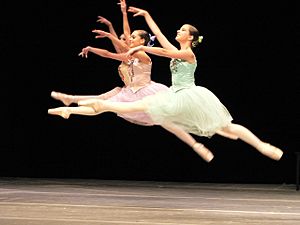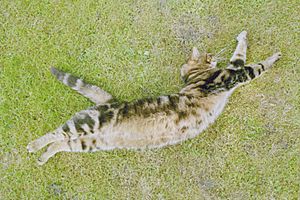Stretching facts for kids
Stretching is a kind of physical fitness exercise in which a muscle (or muscle group) is stretched on purpose to its fullest length in order to help the muscle's elasticity and its tone. This helps a person have better control of his or her muscles and be more flexible.
Stretching, in its most basic form, is a natural and instinctive activity; it is done by many animals including humans. It may be done while yawning. Stretching often is done instinctively after waking from sleep, after long periods of being inactive, or after leaving small spaces and areas.
Many athletes and dancers stretch deliberately before or after exercise in order to enhance performance and reduce injury.
There are three basic types of stretching: ballistic, dynamic, and static stretching.
Related pages
- Weerapong, Pornratshanee, Patria A. Hume, and Gregory S. Kolt. "Stretching: Mechanisms and Benefits for Sports Performance and Injury Prevention." Physical Therapy Reviews 9.4(2004): 189-206.
- LaRoche, Dain, and Declan A. J. Connolly. "Effects of Stretching on Passive Muscle Tension and Response to Eccentric Exercise." American Journal of Sports Medicine 34.6(2006): 1000-1007.
- Shrier, Ian. "When and Whom to Stretch?" Physician & Sportsmedicine 33.3(2005): 22–26.
Images for kids
-
A roller derby athlete stretching
-
Football player Luis Suárez stretching prior to a match.
-
Martin Brodeur stretching on the Devils' bench during warmups.
See also
 In Spanish: Estiramiento para niños
In Spanish: Estiramiento para niños








